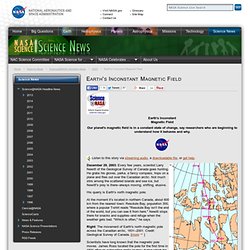

Texte en anglais: champ et animaux. Inquiry: AN OCCASIONAL COLUMN By Peter Tyson Posted 11.18.03 NOVA Would a dramatic change in the Earth's magnetic field affect creatures that rely on it during migration?

Late on a January night in 1993 I found myself on a beach on the Pacific coast of Costa Rica, kneeling in the sand beside a leatherback sea turtle. Like a giant mango with wings, the huge black turtle had hauled herself up the beach in great stentorian gasps of air and was laying her eggs in a pit she had laboriously scooped out with her hind flippers. Knowing basic facts about her ecology and physiology, I was in awe.
How her kind, the largest living reptiles, had been around for 120 million years. The oceans have no signposts, but leatherbacks and other sea turtles find their way in part by tapping into our planet's magnetic field. That navigational and homing ability astonished me more than any other. Magnetic attraction What made it striking was that the birds were in a shuttered room. Undersea superhighways Sources. Texte en anglais sur le mouvement du champ. Earth's Inconstant Magnetic Field Our planet's magnetic field is in a constant state of change, say researchers who are beginning to understand how it behaves and why.

Listen to this story via streaming audio, a downloadable file, or get help. December 29, 2003: Every few years, scientist Larry Newitt of the Geological Survey of Canada goes hunting. He grabs his gloves, parka, a fancy compass, hops on a plane and flies out over the Canadian arctic. Not much stirs among the scattered islands and sea ice, but Newitt's prey is there--always moving, shifting, elusive. His quarry is Earth's north magnetic pole. At the moment it's located in northern Canada, about 600 km from the nearest town: Resolute Bay, population 300, where a popular T-shirt reads "Resolute Bay isn't the end of the world, but you can see it from here.
" Right: The movement of Earth's north magnetic pole across the Canadian arctic, 1831--2001. Scientists have long known that the magnetic pole moves. Probably not. Texte en anglais sur la disparition du champ magnétique. By Rick Groleau Posted 11.18.03 NOVA Every so often—every 250,000 years on average—the Earth’s magnetic poles reverse polarity.

If such a reversal happened today, compass needles would point south rather than north. Here, view a computer-model-generated animation of our planet’s magnetic field, and see what happens during a reversal. To learn how Earth’s magnetic field works, see text below. Launch Interactive Watch a simulated reversal of Earth's magnetic field, from the first signs of instability to the final, inevitable flip. This feature originally appeared on the site for the NOVA program Magnetic Storm. Texte en anglais sur l'inversement magnétique.
If all the compasses in the world started pointing south rather than north, many people might think something very strange, very unusual, and possibly very dangerous was going on.

Doomsayers would have a field day proclaiming the end is nigh, while more rational persons might head straight to scientists for an explanation. Fortunately, those scientists in the know—paleomagnetists, to be exact—would have a ready answer. Such reversals in the Earth's magnetic field, they'd tell you, are, roughly speaking, as common as ice ages. That is, they're terrifically infrequent by human standards, but in geologic terms they happen all the time.
As the time line at right shows, hundreds of times in our planet's history the polarity of the magnetic shield ensheathing the globe has gone from "normal," our current orientation to the north, to "reversed," and back again. The Earth is not alone in this fickleness: The sun's magnetic shield appears to reverse its polarity approximately every 11 years. Le champ magnétique se prépare-t-il à évoluer ? Le Champ magnétique de notre planète bascule sa direction périodiquement, avec le champ magnétique du pôle Nord et Sud échangeant leur place. Un tel revirement pourrait être dramatique pour la société humaine, ou pas, et il y a maintenant des raisons de penser que cela pourrait arriver bientôt… en termes géologiques, au moins. Autrement, cela aura été une période exceptionnellement longue depuis la dernière inversion, les preuves géologiques suggèrent que le champ se retourne environ une fois tous les 450 000 ans et ça dernière inversion remonte à 780 000 années.
Cela, en soi, ne signifie pas nécessairement un retournement imminent, car il y a eu des cas où un million d’années se sont écoulées d’une inversion à l’autre. Un peu plus de 200 000 ans ne semblent pas longs dans la mesure où la planète est concernée, mais cela voudrait dire que les chances pour l’humanité d’avoir à traiter avec une inversion du champ magnétique dans l’avenir, même à long terme, restent extrêmement faibles.
Texte sur le magnétisme en anglais.